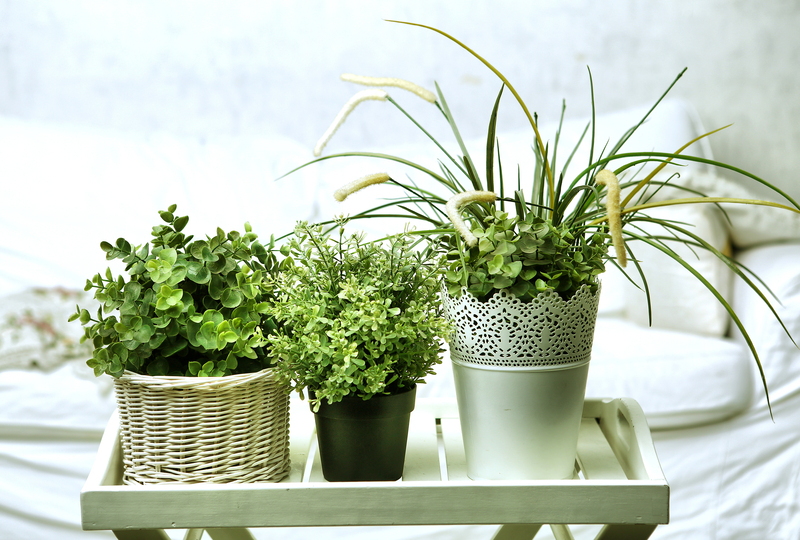Vertical Gardening: Nature's Artistry in Urban Settings
Posted on 02/06/2025
Vertical Gardening: Nature's Artistry in Urban Settings
Amidst concrete jungles and rapidly growing urban populations, vertical gardening has emerged as an innovative solution to reclaim green spaces, enhance aesthetics, and promote sustainability in cities worldwide. This article explores the fascinating world of vertical gardens, delving into their benefits, designs, installation processes, plant choices, and maintenance tips. Join us on a journey into how vertical gardening truly represents nature's artistry in urban settings.
What Is Vertical Gardening?
Vertical gardening, also known as living walls or green walls, refers to the practice of growing plants on vertically suspended panels or structures. Unlike traditional gardens, which spread horizontally across ground surfaces, vertical gardens use innovative techniques to cultivate plants upwards. This method brings lush greenery to places where space is limited, making vertical gardens a popular feature in urban environments.
Key Features of Vertical Gardens:
- Space-saving: Ideal for small apartments, balconies, and public spaces.
- Aesthetic appeal: Creates living art pieces on walls, fences, and facades.
- Improved air quality: Plants help filter pollutants and improve indoor and outdoor air.
- Sustainable design: Promotes biodiversity and conserves resources.

The Evolution of Urban Green Walls
The concept of urban vertical gardening is not entirely new. From the legendary Hanging Gardens of Babylon to modern skyscraper facades adorned with lush greenery, humans have long been captivated by the idea of weaving nature into architectural forms. With growing concerns about climate change, air pollution, and dwindling green spaces, vertical gardening in cities has gained new momentum as an eco-friendly architectural trend.
Modern Innovations in Vertical Gardens
- Hydroponic Systems: Utilize water-based growing media and nutrient solutions to support plant life without soil.
- Modular Planters: Pre-made pockets, panels, or shelves make installation easier and more customizable.
- Automated Irrigation: Drip and misting systems reduce maintenance and ensure consistent growth.
Benefits of Vertical Gardening in Urban Environments
Vertical gardens in cities provide an array of environmental, psychological, and economic benefits. Let's explore the most compelling reasons to consider green wall gardening for your home, office, or civic space.
1. Maximizing Limited Space
Urban dwellings often lack outdoor ground space for traditional gardens. Vertical gardening makes it possible to grow flowers, herbs, fruits, and even vegetables in the tightest of spaces--on balconies, patios, and window ledges. Green walls transform urban landscapes, bringing nature to the eye level even amidst towering buildings.
2. Enhancing City Aesthetics
There's no doubt that a vertical garden serves as a stunning piece of natural artwork. Architects and designers use vertical gardens to create visually captivating facades or vibrant interiors, breathing life into dull or neglected urban corners.
3. Improving Air Quality
Plants naturally absorb carbon dioxide and pollutants while releasing oxygen. Living walls act as natural air filters, improving the quality of indoor and outdoor air. In urban settings plagued by pollution, vertical gardening can significantly reduce harmful airborne particulates and promote healthier environments.
4. Reducing the Urban Heat Island Effect
The proliferation of concrete surfaces in cities creates 'heat islands'--localized zones of increased temperatures. Vertical gardens help regulate temperature by shading and cooling buildings, reducing the reliance on air-conditioning, and lowering overall energy consumption.
5. Encouraging Biodiversity
By providing habitats for insects, birds, and pollinators, vertical gardens promote urban biodiversity. Choosing a variety of native plants can create micro-ecosystems and support wildlife that otherwise struggles to survive in city environments.
6. Psychological Well-being
Exposure to greenery, even through a simple living wall, has well-documented benefits for mental health. Vertical gardening reduces stress, boosts mood, and contributes to a sense of calm and relaxation for residents and passersby alike.
Types of Vertical Gardens
Interested in bringing this touch of nature's artistry to your life? There are several main types of vertical gardens to consider:
1. Wall-Mounted Vertical Gardens
- Pocket planters: Individual fabric or plastic pouches mounted to a wall.
- Modular panels: Interlocking blocks or frames filled with growing media.
- Trellis systems: Structures that support climbing plants and vines.
2. Free-Standing Vertical Gardens
- Tower gardens: Vertical columns with slots or holes for plant growth.
- Freestanding frames: Movable racks or shelves holding pots and planters.
3. DIY and Recycled Designs
- Repurposed materials: Old ladders, pallets, or bottles used creatively.
- Custom installations: Hand-built structures tailored to unique spaces.
Choosing the Right Plants for Your Green Wall
Plant selection is critical for the success of any vertical garden. The ideal choices depend on your location, lighting conditions, climate, and the type of vertical gardening system you use.
Best Plants for Indoor Vertical Gardens:
- Pothos - Hardy, low-maintenance, air-purifying vine.
- Ferns - Add lush texture and thrive in moderate humidity.
- Spider plant - Easy to grow and tolerates varying light levels.
- Philodendron - Attractive, adaptable foliage plants.
- Peace Lily - Elegant, with air-cleaning qualities.
Best Plants for Outdoor Vertical Gardens:
- Succulents - Perfect for sunny, dry environments.
- Herbs (thyme, mint, oregano, basil) - Edible, fragrant, and beautiful.
- Strawberries - Yields sweet fruit in small spaces.
- Climbing vines (ivy, clematis, jasmine) - Quickly cover large surfaces.
- Ornamental flowers (petunias, marigolds, pansies) - Add vibrant color.
Tips for Plant Selection:
- Assess sunlight: Choose plants suitable for your garden's light exposure (shade, partial, or full sun).
- Consider watering needs: Group plants with similar moisture requirements.
- Account for weight: Lightweight, shallow-rooted plants reduce strain on structures.
Designing Your Urban Vertical Garden
Creating a vertical garden is an opportunity to let your creativity flourish. From simple, space-saving garden walls to dramatic living murals, design possibilities are endless.
Design Elements to Consider:
- Structure: Decide whether your vertical garden will be wall-mounted or free-standing.
- Layout: Plan plant positions for visual interest and optimal growth.
- Color palette: Combine plants with contrasting foliage and blooms.
- Texture: Mix delicate ferns, bold succulents, and trailing vines for depth.
- Thematic focus: Herbs for a kitchen wall? Edible greens for a balcony? Ornamental flowers?
Popular Urban Vertical Garden Projects:
- Herb walls in kitchens and restaurants
- Living privacy screens on balconies and terraces
- Indoor air-purifying green walls in offices and schools
- Public art installations for parks, malls, and urban plazas
Installation and Setup Tips for a Successful Vertical Garden
Bringing a vertical garden to life requires thoughtful planning and a bit of handiwork. Here's a step-by-step guide:
1. Evaluate Your Space
- Measure your location's dimensions (height, width, weight capacity).
- Check light exposure and protection from wind or rain.
2. Choose or Build Your Structure
- Select a ready-made vertical garden kit or build your own using weatherproof materials.
- Install mounting hardware securely--safety first!
3. Add Growing Medium
- Use soil, coir, hydroponic mats, or other planting substrates.
- Ensure good drainage to prevent root rot.
4. Arrange and Plant
- Lay out your design before planting for the best aesthetic effect.
- Firmly plant in pockets or modular cells.
5. Install Irrigation
- Set up drip lines, soaker hoses, or hand-watering systems as needed.
- Ensure even water distribution from top to bottom.
Maintaining Your Vertical Garden
A well-maintained green wall offers enduring beauty and benefits, but it does require some care:
- Watering: Monitor soil or substrate moisture. Adjust frequency depending on season and plant type.
- Feeding: Fertilize regularly, especially for hydroponic or non-soil systems.
- Trimming: Prune to control overgrowth and promote healthy, bushy plants.
- Pest management: Check for insects and diseases. Use organic controls when possible.
- System checks: Inspect irrigation and support structures for leaks or damage.
Pro Maintenance Tips:
- Rotate plants periodically for even growth.
- Replace struggling plants with new ones seamlessly.
- Clean irrigation lines to guard against clogs.
Sustainability and the Future of Vertical Urban Gardening
Vertical gardens are more than attractive additions--they are stepping stones towards sustainable urban futures. Green walls can help buildings earn LEED or BREEAM sustainability certifications and inspire eco-conscious development. As living technologies and plant science advance, cities may one day weave vertical vegetation seamlessly with every structure, transforming skylines into thriving green ecosystems.

Why Vertical Gardening Is Here to Stay
The fusion of art, architecture, and nature found in vertical gardens makes them a cornerstone of modern city innovation. Whether you are a city dweller with a tiny balcony, a business owner seeking a healthier workspace, or an architect envisioning climate-resilient buildings, vertical gardening offers a path to greener, more beautiful urban environments.
To recap, vertical gardens:
- Reimagine unused space as lush, living art
- Offer clean air, cooler temperatures, and improved biodiversity
- Can be personalized to suit any taste or scale--indoors or outdoors
- Demonstrate that harmony with nature is possible, even in the densest cities
Getting Started: Your Own Vertical Garden Adventure
Are you ready to bring nature's artistry into your urban setting? Embrace vertical gardening--begin by researching design ideas, selecting the right system, and experimenting with plants that fit your lifestyle. In the journey to greener cities, every vertical garden, big or small, makes a difference.
So lift your garden off the ground, and let your walls breathe with life. Your urban oasis awaits!

